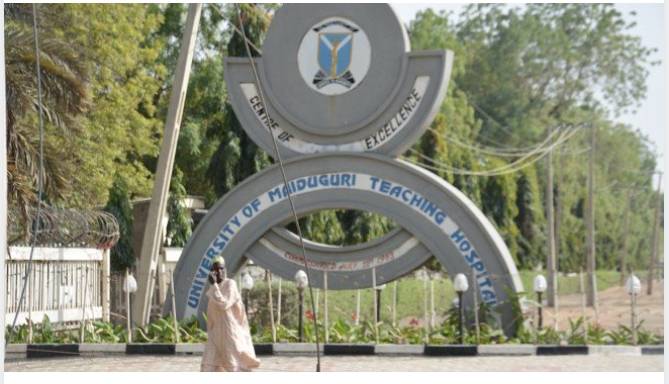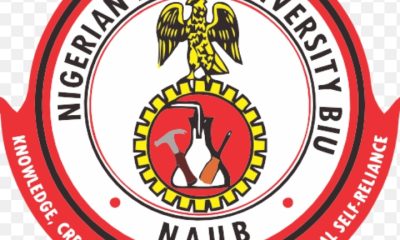Columns
Rice pyramid in Nigeria and matters arising, by Prof M. K. Othman

Rice pyramid in Nigeria and matters arising, by Prof M. K. Othman
Deep Thought with Othman
In the early part of the year, 2013, the Agricultural Complex of Ahmadu Bello University Zaria received members of the Joint House Committee on Agriculture who came for an oversight function.
During the introduction of personalities, the then Executive Director of the Institute for Agricultural Research (IAR), Professor Balarabe Tanimu of blessed memory was introduced as professor of groundnut agronomy, and IAR, a research centre with the mandate of genetic improvement of groundnut among other agricultural commodities. During the opening remarks, the leader of the delegation, a distinguished senator enthusiastically challenged the distinguished scholar, Professor Tanimu, and the Institute to bring back the “great” Kano groundnut pyramid of the 1960s and 1970s. After eulogizing the tireless efforts of the groundnut farmers of that epoch, he pledged a sturdy House support to the Institute with enough budgetary allocation to achieve the challenge.
In his response, Prof. Tanimu appreciated the benevolent gesture of the House members for their keenness to increase the Institute’s budgetary allocation. He stressed the importance of adequate funding for agricultural research as the most viable means of decupling production, addressing production challenges, and/or enhancing crops’ nutrient content.
He assured the guests of IAR’s readiness to judiciously utilize the fund allocation for higher research outputs. He pointed out that even with the inadequate funding, IAR was able to develop new varieties of groundnut, which produced high yield and the quantum of production was much higher than what was being produced in the 1960s and 1970s. Similarly, the level of consumption was much higher due to population increase within the period (about 45 million people in 1960 and 170 million in 2013).
Nonetheless, Tanimu pointed out that reviving the groundnut pyramid was not the aim of IAR. Those pyramids served as aggregation centres for feed-stocking the Agro-industries of foreign countries. Professor Tanimu, an excellent diplomat cum academic, carefully chose his words not to hurt the feelings of the august visitors. Yet, the message was very clear; the groundnut pyramid was a symbol of colonial exploitation and underdevelopment.
Then, groundnut and other cash crops were being produced for exportation to European countries, which were processed and imported into the country at ten times the prices of the raw materials. The best way to produce agricultural commodities is to serve as raw materials to local industries whose products would be locally consumed and exported to other countries. In any case, the commodity pyramid has been one of the performance indicators for measuring agricultural productivity. The simple indicator for measuring productivity is crop output or yield per unit area of production with a unit of Kg/m2 or tons per hectare. So, what was the implication of the Abuja rice pyramid mounted some weeks ago?
Mounting a pyramid of an agricultural commodity such as rice in any part of the country cannot showcase the quantum of production of such a commodity. The associated costs of organising and transporting the commodity to the venue can be overbearing. However, the Abuja rice pyramid event, being the first of its kind, was marked with pomp and pageantry recording a huge success. Although, this success could not stand to represent a success story of boosting rice production but has uniquely packaged hopes for a better future. The presence of top government functionaries and high-profile personalities including President Buhari indicated the willingness of Nigeria’s leadership to support the country achieve food security. The commodity pyramid should not replace the annual agricultural show where innovations, ingenuity, and breakthroughs in the agricultural sector are being packaged and displayed. A few weeks after the rice pyramid event, where do we move? What are the matters arising from the Abuja event?
Fortunately, Nigeria is naturally positioned to achieve greatness in Agriculture; versatile fertile land, huge unquantifiable water resources, and virile and active human resources. In addition to these natural endowments, policies, and programs, over the years were designed to fast-track agricultural development. Theoretically, these programs and projects sound perfect but practically, their implementations have always been haphazardly done thereby retarding their successes. In the last three decades, so many funds were sunk in agriculture in the names of programs and projects without tangible impacts on the productivity of smallholder farmers who constitute ninety per cent of the farming population and contribute eighty-five per cent of national food production.
The major defect of these programs/projects is the lack of an agricultural extension component. Where extension component exists, there has always been incoherent roles and responsibilities because the front extension personnel belongs to the state government while the programs are mostly federal government-sponsored/supported. Today’s agriculture is driven by knowledge and the knowledge is solely facilitated by extension service delivery. In Nigeria, agricultural extension service is poorly funded and poorly manned. How do we move forward?
Agricultural extension entails knowledge transfer, utilization and feedback, market intelligence, skill acquisition and perfection, and productivity enhancement along the value chain of agricultural commodities (crops and livestock). Therefore, special treatment to agricultural extension can be made through fast-tracking the release of the National Agricultural Extension Policy. The policy was already developed and I am privileged to be part of the team that finalised the policy document. The development of the policy was a painstaking national assignment that was done over five years by agricultural experts, technocrats, and academics. Thus, the policy contains ready-made and holistic solutions to the challenges to agricultural extension service delivery.
It also considers what to be done to modernise agriculture holistically now and in the future. Fortunately, the structure of the agricultural extension system at the grassroots level, the Agricultural Development Program (ADP), developed between the 1970s and 1980s with the support of the World Bank, is still in place and robust but ineffective due to gross underfunding.
The policy has taken good care of how to source alternative and sustainable funds to support and develop an agricultural extension system in the country. If the policy becomes operational, it will automatically increase public and private investment in agriculture with special attention to extension services. This will spontaneously escalate agricultural productivity in geometric proportion. The increase in agricultural productivity will cover both crops and livestock farming with positive implications on the livelihoods of the farmers and herders.
In conclusion, instead of having commodity pyramids, efforts should be geared towards adequately funding extension services through legislation of agricultural extension policy. This will sooner than later bring the desired result of achieving food security, reducing poverty, and creating jobs for millions of Nigerians.
Columns
Medical and Health Developments Amidst Insecurity: The Case of University of Maiduguri Teaching Hospital (UMTH)

Medical and Health Developments Amidst Insecurity: The Case of University of Maiduguri Teaching Hospital (UMTH)
By: Balami Lazarus
Insecurity challenges have pervaded and taken over every inch of the Nigerian estate, spreading their wings, casting dark shadows stealthily in silence of ambush. The predator has created excuses against growth, progress, and development among ministries, departments, and agencies (MIDA’s), including health institutions where medical and healthcare services are needed.
Development means a different thing to many people. “An improvement in people’s living conditions inevitably contributes to higher productivity and to economic growth, subsequently development.” Therefore the needs of people in a particular area are their development. For example, health.
Moreover, development is essentially concerned with continuous improvements of the human life and condition right from time, in its capacity for qualitative and quantitative reproduction and capabilities to control and manipulate the environment for the betterment of mankind as a whole. Therefore, the purpose of development is to create an enabling environment for people to enjoy long, healthy, and creative lives at all levels of their growth and progress.
But for UMTH under Prof. Ahmed Ahidjo, the CMD, medical and health development in infrastructure, human capital, and healthcare services is a continuous process amidst insecurity in Borno State and Maiduguri, the state capital.
At UMTH, the story of growth and development has brought progress in health and medical services that are expected from institutional hospitals. The rate and level of medical and healthcare services through specialized medical centers equipped with modern state-of-the-art equipment second to none in Nigeria is a testament to health/medical development in the aforesaid hospital.
People have always examined the concept of growth and development from economic perspectives, refusing to align them to the objectives of human needs that will increase productivity to provide and satisfy these human needs to ensure good medical and healthcare service delivery that is available at all times in UMTH “Centre of Excellence.”
Prof. Ahidjo has no doubt facilitated the concept of health development through changes in the health and medical services provided by UMTH in spite of the ten security challenges staring us hard in the face.
Growth, progress, and development initiated by Prof. Ahmed Ahidjo is itself a concept of development in the health sector. The CMD has blended the concepts of development together through their aims and objectives, which are charted towards the improvements of the human standard of living in healthcare and medical services.
Prof. Ahmed’s efforts have therefore brought developments in the life of the hospital that have never been witnessed since the inception of UMTH, until the man with the Midas touch came on board with improvements and transformations of infrastructures and facilities.
Prof. Ahidjo had directed his development towards the satisfaction of the hospital’s needs, the primary objectives of UMTH, which translates to human capital development through teaching, practicals, medical research, and provisions of healthcare services to her immediate host community.
Therefore, development cannot be seen purely as economic, social, and political affairs but rather as an outcome of man’s effort to transform societal structures and institutions in the case of UMTH.
Balami, a Publisher/Columnist 08036779290
Medical and Health Developments Amidst Insecurity: The Case of University of Maiduguri Teaching Hospital (UMTH)
Columns
In Search of Our History Through Reconstruction and Restructuring of the Nigerian State for Peaceful Coexistence and Good Governance

In Search of Our History Through Reconstruction and Restructuring of the Nigerian State for Peaceful Coexistence and Good Governance
By: Balami Lazarus
This piece is an extraction from a paper I wrote years back intended to be presented to my society—the Borno Museum Society (BSM)—but it never saw the light of day. However, this is not the original title; I did some changes, putting in some terms to reflect the contemporary issues facing us currently as Nigerians.
Looking at the paper today, which had lain fallow since 1991, I laughed. Dr. Musa Hambolu and Mr. Kyari Bukar, as members, encouraged and urged me to make an effort and present the paper for onward publication in our newsletter, but it never happened. I believe this version will make sense to many more who believe in the Nigerian project as a sovereign nation.
And back to the main menu of the discourse.
One of the major historical developments in Africa south of the Sahara was the great Bantu migration that took place thousands of years ago. It was a mass exodus of the Bantu people, culture, and traditions; its droplets along the line of their migration gave birth to settlements, which had affected many ethnic nations’ language, culture, and traditions. What happened later is part of African history. We are now nestled between who are we? And what are we?
It is very clear that the reconstruction of our history through the restructuring of Nigeria and its state and conditions has long been toyed with, knowing fully well that it is the heart of our peaceful coexistence and good governance. It’s also the main bowl of our socio-political and economic growth and developments.
Our history, geography, and ethnology have drawn our attention to the state of sovereignty known, called, and addressed as Nigeria, a colonial creation, forgetting that we were here before.
the white man’s creation.
To trace the origin of the people that made up Nigeria, one cannot dismiss the substance of other disciplines like history, archeology, anthropology, geography, sociology, and linguistics, and other related subjects. These fields of scholarships have tremendously improved in the explanations of our history, artifacts, and cultural source materials of the people that were wrongfully and forcefully brought together to live and form Nigeria. Therefore,
There is the need for the restructuring of the Nigerian state for peace and good governance for the benefit of all citizens.
To achieve this, we must collectively agree with one voice to restructure our systems to find a lasting solution to our torn political garment, unity shredded with suspicion generated by us over the years. Because modernization is the process of change towards social, economic, and political systems.
Historically, Nigeria is a conglomerate of large ethnic diversities, and each represents a distinct nation with different cultures, traditions, and civilizations living independently before the forceful amalgamation of 1st January, 1914, carried out and executed by the British colonial masters. Sources available to political historians on our past underscored the necessity to shift from the present state of nationhood to a common ground that will provide us with equal opportunities to maintain and sustain our togetherness as one indivisible and indissoluble nation through reconstruction and restructuring.
The reconstruction and restructuring of our historical and political past is paramount; it will aid in checking the high rate of insecurity and criminal activities of bandits and kidnappers. And shall also clamp down on terrorists and the rise of insurgents. Restructuring will reduce sentiments and segregation in the activities of our national life.
History does not repeat itself. But people repeat history and then falsely accuse history of repeating itself.
We have consciously decided to polarize our country with Black Strike sentiments. And here we are, with agitations in different forms: Oduduwa, Biafra, Middle Belt, and Niger Delta.
Balami, Publisher/Columnist 08036779290
In Search of Our History Through Reconstruction and Restructuring of the Nigerian State for Peaceful Coexistence and Good Governance
Columns
Aspirations: A Compass for a Purposeful Journey of Life

Aspirations: A Compass for a Purposeful Journey of Life
By: Harmony Shimbura
A blueprint for a purposeful journey, the human experience is often defined not by where we are looking, but by having aspirations, a compass of purposeful life, and an act of claiming agency over one’s future.
My life’s aspirations are not merely a list of goals or a collection of ‘bucket list’ items. It is a living philosophy, a commitment to growth, connection, and the relentless pursuit of a life lived with intention. They are threads woven together for personal values and to give back to your community.
I believed the core of aspirations should be a desire for perpetual evolution. And I also believe that the moment we stop learning is the moment we stop breathing. Therefore, one of my primary goals is to remain a lifelong student where learning is a continuous process.
I aspire to deepen my understanding of the world through diverse perspectives, whether it is through traveling to places where knowledge is obtained by listening or observations, as is the case with the traditional Cherokee ways of learning.
I constantly challenge my own biases, spiritually and mentally. I aspire to reach the state of equilibrium where my peace is not dependent on external circumstances.
Do you know that aspirations transcend titles and salary brackets? Moreover, my true ambition is practical impact. I want to be engaged in work that I feel is the extension of my soul in it at whichever level. I also
I believe that work should be a contribution to the collective good of humanity.
As a young lady, I am on the self-push to achieve a level of mastery in my chosen field where my intuition is as sharp as my skills. I want to be known not just for what I did, but for how I did it with integrity, excellence, and a collaborative spirit.
Most of us neglect the vessel that carries us through life, but I aspire to treat my body with the respect it deserves. My aspirations for health are not about vanity but for sanity in purity.
These aspirations are not a destination I will one day reach; they are the fuel for a lifelong journey.
Harmony Shimbura writes from Zaria. 07033886918
Aspirations: A Compass for a Purposeful Journey of Life
-

 News2 years ago
News2 years agoRoger Federer’s Shock as DNA Results Reveal Myla and Charlene Are Not His Biological Children
-

 Opinions4 years ago
Opinions4 years agoTHE PLIGHT OF FARIDA
-

 News9 months ago
News9 months agoFAILED COUP IN BURKINA FASO: HOW TRAORÉ NARROWLY ESCAPED ASSASSINATION PLOT AMID FOREIGN INTERFERENCE CLAIMS
-

 Opinions4 years ago
Opinions4 years agoPOLICE CHARGE ROOMS, A MINTING PRESS
-

 News2 years ago
News2 years agoEYN: Rev. Billi, Distortion of History, and The Living Tamarind Tree
-

 ACADEMICS2 years ago
ACADEMICS2 years agoA History of Biu” (2015) and The Lingering Bura-Pabir Question (1)
-

 Columns2 years ago
Columns2 years agoArmy University Biu: There is certain interest, but certainly not from Borno.
-

 Opinions2 years ago
Opinions2 years agoTinubu,Shettima: The epidemic of economic, insecurity in Nigeria





